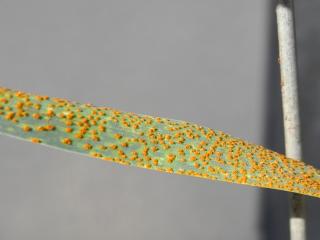Wheat growers in Western Australia are encouraged to monitor crops throughout the season for signs of leaf rust following testing which has confirmed an increased risk of rust in popular wheat varieties.
Department of Agriculture and Food plant pathologist Geoff Thomas said that in 2013, wheat leaf rust with increased virulence for several popular varieties was discovered in WA.
Testing through the Australian Cereal Rust Control Program at Sydney University confirmed the presence of the leaf rust pathotype named 76-1,3,5,7,9,10,12 +Lr37.
“This represents the first occurrence in WA of virulence for varieties which contain Lr13 resistance. As a result, several varieties, including Mace, are expected to have an altered response in the presence of this pathotype,” Mr Thomas said.
“In order to gauge the rust response of wheat varieties popular in WA, the Department recently completed glasshouse trials to test the seedling and adult reactions of varieties to this new pathotype,” he said.
“Our pathology tests confirmed that varieties Mace, Wyalkatchem and Corack, which all carry Lr13, are susceptible (S) as seedlings and moderately susceptible to susceptible (MS-S) as adult plants.
“This result signifies a significant reduction in resistance from the moderately-resistant (MR) response of these varieties to the former dominant rust pathotype in WA.
“Other varieties identified in our tests as having increased susceptibility included Bonnie Rock, Emu Rock and, to a lesser degree, Fortune,” he said.
“The varieties Cobra and Carnamah were not adversely affected by the change of pathotype. Magenta, which carries an alternate resistance source (Lr24), remains resistant to both rust pathotypes present in WA last season.”
Mr Thomas said, given the widespread plantings of Mace, Wyalkatchem and Corack, a significant proportion of the State’s wheat-growing areas would be at least moderately susceptible to leaf rust if the new pathotype persisted.
“This has serious implications for crops planted in 2014 and potentially represents the greatest shift in rust susceptibility in WA for more than 10 years,” Mr Thomas said.
“Growers should monitor their crops throughout the season and be aware of disease developments in their local area.
“Monitoring, early detection and reporting of rust will improve disease management outcomes for the grains industry.”
Occurrences of rust in crops or regrowth should be reported to the department by emailing PestFax or completing an online report here.
A report of leaf rust on Mace regrowth in the lower Great Southern was recently confirmed, highlighting the risk to nearby areas and possibly other regions.
Mr Thomas said the application of a registered foliar fungicide when the disease first becomes apparent and before it fully establishes in a crop provides the best management of leaf rust in susceptible wheat varieties.
”The early detection and awareness of changes in rust pathotypes enables the grains industry to direct resources to the areas of most need,” he said.
Cereal rust samples can be submitted for pathotype analysis by mailing them in a paper envelope (not wrapped in plastic or using a plastic-lined envelope) to the Australian Cereal Rust Survey, Plant Breeding Institute, Private Bag 4011, Narellan NSW 2567 or call (0)2 9351 8800.
Alternatively, growers can deliver samples to their nearest Department of Agriculture and Food office to be forwarded for testing.
More details about the new rust pathotype are available on the University of Sydney Plant Breeding Institute website.

Media contacts: Jodie Thomson/Dionne Tindale, media liaison 61 (0)8 9368 3937
